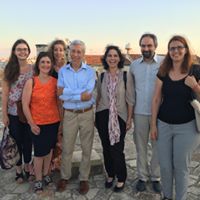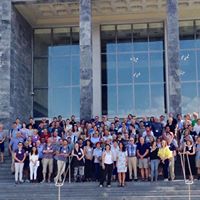The Pitt lab would like to thank the BHF for highlighting our work as “breaking new ground” in the fight against heart disease in the 2017 annual report Scotland. We are grateful to the BHF for their continued support of our research.
 sjp24
sjp24
Zinc and sarcoplasmic calcium leak – Paper accepted in JBC
The paper is out!!! Many thanks to the BHF for supporting this work
Dysregulated Zn2+ homeostasis impairs cardiac type-2 ryanodine receptor and mitsugumin 23 functions, leading to sarcoplasmic reticulum Ca2+ leakage
Abstract
Aberrant Zn2+-homeostasis is associated with dysregulated intracellular Ca2+ release resulting in chronic heart failure. In the failing heart, a small population of cardiac ryanodine receptors (RyR2) display sub-conductance state gating leading to Ca2+ leakage from sarcoplasmic reticulum (SR) stores, which impairs cardiac contractility. Previous evidence suggests contribution of RyR2-independent Ca2+ leakage through an uncharacterized mechanism. We sought to examine the role of Zn2+ in shaping intracellular Ca2+ release in cardiac muscle. Cardiac SR vesicles prepared from sheep or mouse ventricular tissue were incorporated into phospholipid bilayers under voltage-clamp conditions, and the direct action of Zn2+ on RyR2 channel function was examined. Under diastolic conditions, the addition of pathophysiological concentrations of Zn2+ (≥2nM) caused dysregulated RyR2-channel openings. Our data also revealed that RyR2 channels are not the only SR Ca2+-permeable channels regulated by Zn2+. Elevating the cytosolic Zn2+ concentration to 1 nM increased the activity of the transmembrane protein mitsugumin 23 (MG23). The current amplitude of the MG23 full-open state was consistent with that previously reported for RyR2 sub-conductance gating, suggesting that in heart failure in which Zn2+ levels are elevated, RyR2 channels do not gate in a sub-conductance state, but rather MG23 gating becomes more apparent. We also show that in H9C2 cells exposed to ischemic conditions, intracellular Zn2+ levels are elevated, coinciding with increased MG23 expression. In conclusion, these data suggest that dysregulated Zn2+ homeostasis alters the function of both RyR2 and MG23 and that both ion channels play a key role in diastolic SR Ca2+ leakage.
Here is a link to the paper
http://www.jbc.org/content/early/2017/06/19/jbc.M117.781708.full.pdf?with-ds=yes
International Society for Zinc Biology
The 2017 ISZB meeting took place in Pyla, Cyprus 18th-22nd June in collaboration with Zinc-NET. Dr Samantha Pitt would like to thank the organisers Nicola Lowe, Kathryn Taylor, Belma Turan and Michal Hershfinkel for putting together such an exciting programme. Samantha Pitt gave a talk entitiled “Dysregulated zinc may lead to ‘leaky’ calcium channels in heart failure”
Prize for best honours research dissertation
The Pitt lab would like to congratulate Lara Beaumont on receiving the Dean of Medicine prize and the Professor Andrew C. Riches prize for the best lab based honours research project.
Lara was a recipient of the Wolfson Foundation Intercalated degree award when she joined our group to investigate how zinc regulates calcium release in heart failure. It was a real pleasure to have Lara in the lab and we wish her every success for the future.
Chrysalis- An artistic interpretation of pursuing scientific research
Dr Pitt took part in the Chrysalis project; an artistic interpretation of pursuing scientific research. This project was funded by the Biochemical Society Diversity in Science Fund and the Wellcome Trust’s Institutional Strategic Support Fund.
 Professional local artist Sophie McKay Knight met both young and established female researchers at the University of St Andrews to examine how creativity and imagination are required, as well as integrity and precision when pursuing scientific research. Sophie visited our lab to find out about the day-to-day life of a scientist and to learn more about our current research. The conversations the group had with Sophie and some of current data were interpreted into artwork which formed part of an exhibition entitled Elements, 23 March – 30 April 2016 at the Byre Theatre, St Andrews.
Professional local artist Sophie McKay Knight met both young and established female researchers at the University of St Andrews to examine how creativity and imagination are required, as well as integrity and precision when pursuing scientific research. Sophie visited our lab to find out about the day-to-day life of a scientist and to learn more about our current research. The conversations the group had with Sophie and some of current data were interpreted into artwork which formed part of an exhibition entitled Elements, 23 March – 30 April 2016 at the Byre Theatre, St Andrews.
Biophysical Society Annual Meeting 2016
The Pitt lab attended the Biophysical Society 60th Annual Meeting, Los Angeles, Feb 27-March 2, 2016. Both Gavin Robertson and Benedict Reilly-O’Donnell presented their work. Gavin’s poster was entitled ‘Zinc modulates skeletal ryanodine receptor function resulting in altered sarcoplasmic reticulum calcium release’. Gavin is funded by the BHF. Ben presented a poster entitled ‘Diastolic calcium leak and the role of zinc’. Both Gavin and Ben received a travel award from the Physiological Society. Ben also received additional support from the British Society of Cell Biology. The conference was both helpful and informative and we look forward to presenting more data in the future.
Royal Society of Edinburgh – Small Equipment Grant
Dr Samantha Pitt would like to thank the Royal Society of Edinburgh for awarding her a small equipment grant which will be used to buy a new florescent microscope for the patch rig and for their continued support of her research.
Zinc-UK meeting, London, December 2015
Another fantastic Zinc-UK meeting!
The Pitt and Stewart labs attended the Zinc-UK meeting, London 2015 and would like to thank Dr Imre Lengyel and Dr Elisa Bellomo for putting together such an exciting programme.
Dr Samantha Pitt would like to thank the organisers for giving her the opportunity to talk about the lab’s latest research and gave a talk entitled “Zinc unmasks a new player in cardiac sarcoplasmic reticulum calcium leak”.
Well done to Ben and Gavin who both presented their work at this meeting. Ben gave an oral presentation entitled “The role of zinc in regulating intracellular calcium release” and Gavin presented a poster entitled “A novel role for Zn2+ in modulation of sarcoplasmic reticulum calcium release in skeletal muscle”.
The Pitt lab would like to thank the Royal Society of Edinburgh and the BHF for supporting this research.
Microelectrode Techniques for Cell Physiology – 2015
Another fantastic year.
A special thanks to Alex Street (The Marine Biological Association, Plymouth) and to Prof. David Ogden (Paris Descartes & The Francis Crick Institute, London) for organising another successful year.
2015 was the year of the patch clamp!!! We successfully recorded whole cell currents using both conventional whole cell patch clamp and perforated patch, and also recorded some beautiful single channels using cell attached, outside-out and inside-out patches.
For students thinking of applying or wishing to find out more about the course, please visit Microelectrode Techniques for Cell Physiology 2016
Zinc controls RyR2 activity during excitation-contraction coupling
Read our auto-commentary here:







